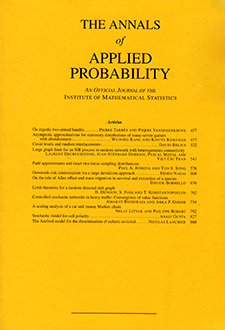Abstract
We study the distributions of the areas under the positive parts of a Brownian motion process B and a Brownian bridge process U: with $A^+ = \int_0^1 B^+ (t) dt$ and $A_0^+ = \int_0^1 U^+ (t) dt$, we use excursion theory to show that the Laplace transforms $\Psi^+ (s) = E \exp (-sA^+)$ and $\Psi_0^+ (s) = E \exp (-sA_0^+)$ of $A^+$ of $A_0^+$ satisfy $$\int_0^{\infty} e^{-\lambda s \Psi +} (\sqrt{2} s^{3/2}) ds = \frac{\lambda^{-1/2} Ai(\lambda) + (1/3 - \int_0^{\lambda} Ai(t) dt)}{\sqrt{\lambda} Ai(\lambda) - Ai (\lambda)}.$$ and $$\int_0^{\infty} \frac{e^{-\lambda s}{\sqrt{s}} \Psi_0^+ (\sqrt{2} s^{3/2}) ds = 2 \sqrt{\pi} \frac{Ai(\lambda)}{\sqrt{\lambda} Ai'(\lambda) - Ai(\lambda)}.$$ where Ai is Airy's function. At the same time, our approach via excursion theory unifies previous calculations of this type due to Kac, Groeneboom, Louchard, Shepp and Takács for other Brownian areas. Similarly, we use excursion theory to obtain recursion formulas for the moments of the "positive part" areas. We have not yet succeeded in inverting the double Laplace transforms because of the structure of the function appearing in the denominators, namely, $\sqrt{\lambda} Ai(\lambda) - Ai'(\lambda)$.
Citation
Mihael Perman. Jon A. Wellner. "On the distribution of Brownian areas." Ann. Appl. Probab. 6 (4) 1091 - 1111, November 1996. https://doi.org/10.1214/aoap/1035463325
Information





